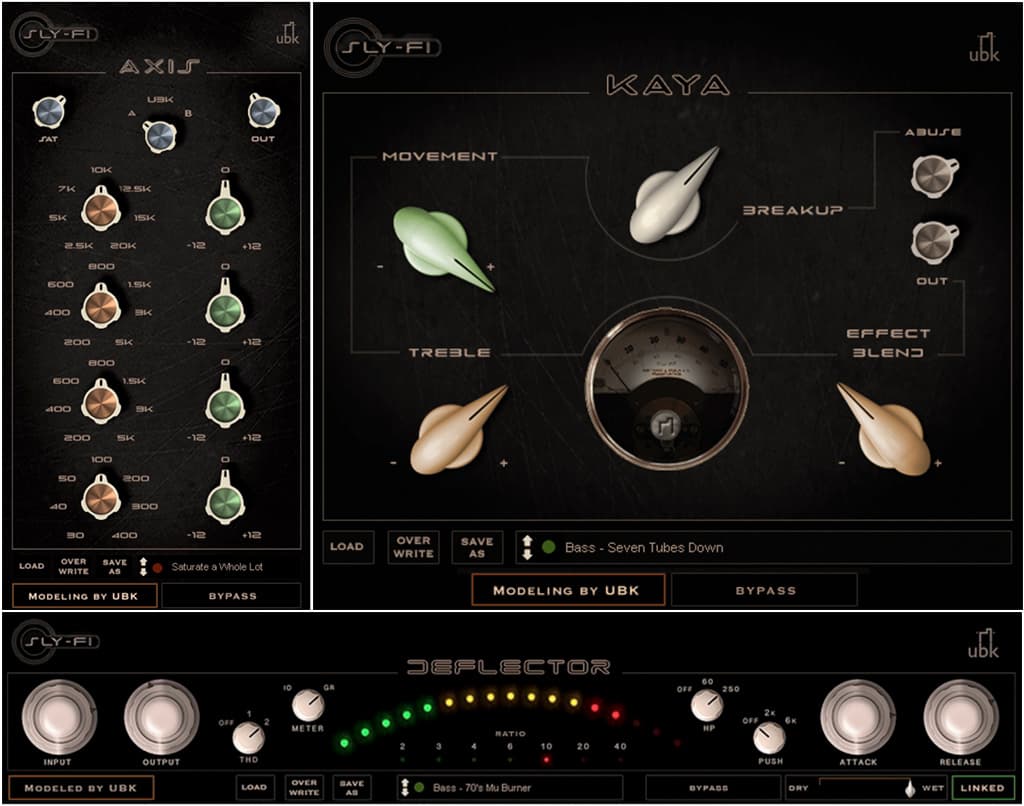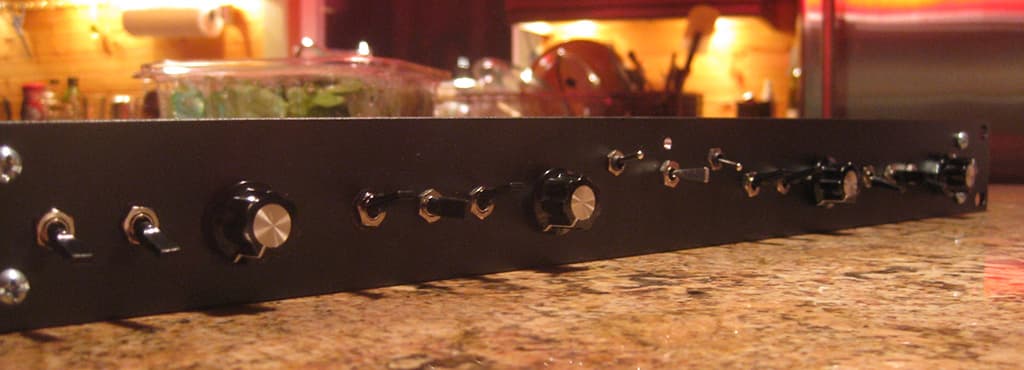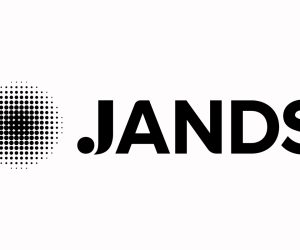
From Modding To Modelling
UBK got its start modding Empirical Labs’ analogue Fatso, now Gregory Scott is digitally modding the Distressor. We talk about his new company Sly-Fi Digital, and which is better, analogue or digital?
Holidays were done differently in 1982; quite a bit differently under Gregory Scott’s guidance. 10-year old Gregory’s parents had bundled the kids into the car for a guided cassette tour of Nova Scotia. Its running commentary steering the Scott’s on a course between significant Canadian landmarks… mostly lighthouses.
Young Gregory had just requisitioned his first tape deck but had no material to try out his new contraption with. Then it dawned on him that they’d been listening to a tape all day; a tape he could record on. Blithely he popped his parent’s cassette out of the car console as they pulled in for the day. Later that night, beneath the doona cover he slipped a piece of tape over the erase tab and began playing it back, stopping every now and again to record. The next day the Scott family holiday was punctuated with Gregory’s mod — a fresh, inappropriate, look at the Nova Scotian landscape — which his parents, without flinching, listened to for the rest of the trip.
LIFE IS ONE BIG MOD
Being a world-class modder of audio gear (UBK Fatso), hardware designer (Clariphonic, Electra EQ and Tweaker) and plug-in developer (House of Kush and new company Sly-Fi), I figured Scott’s childhood would have included more torn-down radios than wisecracks. He’s a joker, for sure, just listen to his UBK Happy Funtime Hour podcast for a taste. But taking a soldering iron to his dad’s hi-fi equipment would have been one hi-jinx too far. “He was upgrading his rig every two years,” said Scott. “Amazing headphones, quadraphonic; whatever was ‘the latest’, my dad was spending money we didn’t have on it.” But he was grateful for his father’s habit because young Gregory was indoctrinated with great sound, not merely sound engineering practice.
With hindsight, Gregory’s life looks as planned out as a Nova Scotian sightseeing tour, but his take is that he got “sucked into the life” by doing things he typically wouldn’t. It all started off with a Gearslutz user gathering — an ‘I’ll show you mine if you show me yours’ of audio gear. He’s a self-described hermit, so when he told his girlfriend (now wife) he was planning to hitch a ride along, it raised both eyebrows. When he arrived, Scott recalls the room being divided in half like a school dance — people that seemed younger than him on one side, and a group that seemed older on the other. The older guys were laughing, so he joined them. That night he met Gil Griffith, owner of Wave Distribution and distributor of Dave Derr’s Empirical Labs.
They hit it off, and Scott left Griffiths with the open-ended promise, ‘whatever you need…’ A while later he was at a tradeshow helping out on the Wave Distribution stand and noticed people vibing with the ELI Distressor but walking away confused by the Fatso. Surveying the crowd, he realised people were instantly gelling with the Distressor’s distortion characteristics and a bit bemused as to why they weren’t getting the same effects from the more polite Fatso. He took the idea of a more aggressive Fatso to Griffiths, who sent him over to Dave Derr.
Scott had never planned to be a builder of gear, so when he rocked up to Derr’s Empirical Labs headquarters for a Fatso modding how-to, he wasn’t expecting to get more than a few bucks a unit. “We took it to Dave,” said Scott. “And he was like, ‘I don’t even want to know what you did, just sell it on your own and make sure your customers don’t bother me.’” With Derr’s ‘blessing’, he and Griffith formed a business and started shipping units.
Scott’s next meeting of fate was when he moved home for a year to house sit his parent’s place and met Kevin. Kevin’s the same age as Scott, and they would have met years earlier in high school if they hadn’t lived in different districts. He’s also a DIY gear obsessive. These days, Kevin does the mid-level implementation of Scott’s analogue hardware designs for Kush. While Scott’s completely at home hacking a device’s output over a bread board, some jumper wires and a rough schematic, he prefers to let a more steadied hand fret about the final layout. “I get something basic cobbled together then give it to this genius and he makes it a million time better, then he hands it to another genius and makes it another million times better than that,” explained Scott. “They send me the first prototype and then I start tweaking from there. I usually do about four different prototypes of a piece of gear.”
SLY-FI: A NEW ADVENTURE
Since then Scott has flipped between a mix of hardware and software products, occasionally leafing through his journal of 37 product ideas to find a fresh challenge. His latest are three plug-ins from an entirely new company called Sly-Fi Digital: the Deflector compressor, Axis EQ, and a one-trick pony mystery box named Kaya. Scott has no real answer as to why he started a new company to launch the new plug-ins, he just chocks it up to instinct; instincts that have served him well so far. And then there’s his bizarre logic, “It makes for a fun job and having two companies is half the work.” … right.
Scott: “Prototype of the first Clariphonic, at the time it was called Clarity Control. We did this last-minute measure because the silkscreened ‘Clarity Control’ panel was no good due to a call from a software company saying, ‘Clarity is trademarked.’ My response, being a law school dropout, was that a single word that’s used in common parlance is not a legit trademark, it has to be a unique word or word combination (like, oh, Clarity Control), or a word used completely out of context, like calling a soap ‘Tide’, or a computer ‘Apple’. He said, ‘Is it going to be like that?’ And the thought came to me to be more clever, so I let it go and later that night came up with Clariphonic, which I reckon is way better. We got the bubbles smoothed out and no one at the trade show noticed it was a sticker.”


DEFLECTOR: ORIGINAL DISTRESSED
The first of the three plug-ins has brought Scott right back to Derr’s front door. The Deflector is Scott’s take on the Empirical Labs Distressor. “I had just come off the UBK Fatso and became really obsessed with what else I could mod. Nothing in my rack was sacred. I loved all the gear I had but no piece of gear is flawless to anybody’s ears. You buy something and there’s gonna be 10 things you love about it and one thing you don’t.
“Primarily I wanted to see if I could make the Distressor tonally neutral. It has a specific forward sound that most people love. I wanted to just hear the compression and none of the distorted forwardness it had.”
AudioTechnology: “What does Dave think about you releasing the plug-in? At least with the Fatso you had to buy the original units to mod them.”
Gregory Scott: “I don’t even know if Dave is aware this plug-in exists, and I don’t know if he would care. It’s very purposefully not a Distressor. It’s definitely in the same family but the Distressor is hardware and this is a plug-in. I know there’s another company coming out with their Distressor soon, and I’m curious to hear it.
“My main complaint with all plug-ins, including my own, is that they don’t have the same transient behaviour as analogue does. It’s not that analogue is better, it’s just that the analogue version does a specific thing.”
AT: “What’s the main difference?”
GS: “It’s all in the transients — half a millisecond to a millisecond of sound at the most. It’s mostly the speed and therefore the frequency of the sound’s leading edge. The waveform is either coming at you or pulling away from you at the speaker, right? So a transient is everything that’s moving forward. Analogue, no matter how transparent or clear it is will slow that. It just shaves it off, ‘you’re not going any faster than this’. It’s got physical limits. No matter what you do in digital, it’s way too fast. To my ears, there’s a form of brightness to the sound that cannot be drawn out.
“The opposite is true. There’s something about the slowness, and it just gets slower the more coloured gear you’ve got in the path. Analogue sound is slowing down the high frequencies, making the bass come out phase shifted a little ahead in time. Digital can’t do that yet, though it may someday. I actually don’t think it will. I think they’re just mediums that are always destined to sound a little different.”
AXIS: DARKER CURVES
It’s this balance between analogue and digital advantages that endears plug-ins to Scott’s desire for modded gear. Case in point, the Axis EQ, which is an homage to another famous piece of gear, the API EQ, but modified without having to swap out physical components. “I modelled the original API and tightened it up digitally,” said Scott. “It’s a lot of components to change without being sure I’m going to even like the result. So it’s really cool to take the modding mentality into digital and hybridise it.
“Some things are modded in the analogue gear itself. I’ll then model that and mod it more in the digital realm, either to do things I couldn’t do in analogue or are just too much of a pain in the butt. I don’t want to change 56 capacitors to tighten up the curves, let me just turn a knob to tighten them up digitally.”
Other parts require a bit more of a learning curve to get close to its analogue counterpart. Specifically, getting curves to hold their shape at the high end, explains Scott: “Oversampling and a few other techniques will effect what happens at the Nyquist frequency on anything over 10kHz. If you don’t do anything, it rolls off really fast and tilts what is normally a symmetrical curve in analogue. You lose more air the higher you make the filter. There are things you can do that bring that digital curve back to a more symmetrical profile, which results in a smoother tone.”
Scott and his unnamed Danish programmer have learnt a lot since building the Electra DSP EQ plug-in that came before Axis. It required a lot of DSP to achieve the same curves in the high end as the hardware Electra. Working out how to make the process more efficient without losing any detail required plenty of coding nous, resulting in the CPU demand being halved between the alpha and final release. Naturally, Axis benefitted from the continuation of that pursuit and carries similar principles while being even leaner.
Of course, it’s not Electra either, and Scott points out the two main elements that distinguish Axis: “The core algorithm that calculates what frequency I am moving and by how much, as far as I know, that’s kind of the same in every EQ that’s ever been made. There’s just shelves, pads, tricks and tweezes you do to that basic algorithm so that by the time it fully executes the end product, it’s got a different sound. Axis sits between Electra and an API EQ in terms of the tightness of the curve. Electra is super-tight and the API is super-broad. Axis leans towards the API but is in between the two.
“I also got aggressive with making Axis dark. A lot of people have been shouting from the rooftops for years that if you low-pass everything at 18kHz it will sound better. So that’s what I did. Before it does any processing and especially before it generates any harmonics, it gets rid of that hash. In digital, if you just do simple things in the right order it can really help you out a lot.
“I’m trying to build tools that factor in all these tiny variables. I’m not inventing anything, I’m just arranging parts in a new or different way that I think brings something different to the table.”


KAYA: MAXIMUM SAG
The third Sly-Fi Digital plug-in is as close as you’ll get to plug-in pot luck. Send Kaya a signal and there’s no guarantees you’ll come out with something usable. Scott took engineer S. Husky Höskulds’ one-off ‘Pa’ contraption, which is basically an Ampex tube tape deck, where the preamp is wired to the tape head. “It’s absurd,” said Scott. “It’s like the tube preamp is spitting out, I don’t know, 200 times the maximum voltage that tape head ever wants to see.” He whacked a few more controls on the unit to hopefully present some of Pa’s charm to users in a usable way, but it still doesn’t come close to the randomness of the original. “There are things the hardware can do that I couldn’t even come close to modelling. It has a specific sag when you really hit it with a kick drum that we were hoping to capture, but nope, just not there. It’s one of those things that only tubes, this weird thing in the middle with a tape head, and more tubes and transformers can do. It’s not for everyone.”
SATURATION OBSESSION
Toying with compression and saturation has been a lifelong pursuit for Scott. It started with juicing up the Fatso’s saturation, and everything since has had a colour to it. Even Axis, an EQ, has a knob for dialling in saturation. He likes to tell a story about how Michael Brauer introduced him to the concept of using compression for movement, not just dynamic control. And it turns out he had a similar formative experience with saturation.
Scott: “I used to be heavily into prog-rock when I was a teenager, particularly older Yes from the late ’60s and early ’70s which was heavily tinged with psychedelic and jazz.
“I’m not really into it anymore, but for whatever reason I saw a 130g extra thick vinyl re-issue of Yes’s album Fragile on eBay, and thought, ‘What the hell, I’ll grab this record.’ I hadn’t heard it since I was 20 years old, and I could not believe the amount of distortion on it. It was so dark and punchy; I hadn’t heard that sound in so long. I thought, ‘Man that’s beautiful, I need to incorporate some of that into what I’m doing.’
“So that was my a-ha moment. Distortions matter tremendously.”
I don’t even know if Dave is aware this plug-in exists, and I don’t know if he would care. It’s very purposefully not a Distressor




UBK’s stable of plug-ins with some novel nomenclature
LATERAL LABELLING
Scott’s mind isn’t typical for a technical person, and his plug-ins reflect that. They don’t always hold to engineering convention. At times, face plates read like a Batman comic, such as the Splat and Crush compression styles on the UBK-1. Other times, like on Pusher, he merely references knobs and switches with pictograms — more magnet please! On Electra DSP, there’s no frequency markings other than a broad operating range for each band.
Scott: “The language on the products reflects how I actually think and communicate. It’s not a gimmick to put fluffy words on there because it’s ‘so cool!’ I never think, ‘there’s too much 300Hz on that vocal’ because I wasn’t trained. If I was trained, then my EQs would probably say 300Hz. I have no judgments about it. I just know it’s not helpful for me to have numbers on there. If the snare drum sounds too thuddy, I know where on my EQ I need to tune to cut that out.
“I have been strongly considering giving Electra an option where you can click a little switch and it tells you the frequency you’re around. Because I respect that at the end of the day the products are not just for me anymore, they’re for everybody. On one hand I want people to just listen. But if it causes somebody not to use the Electra, I don’t give a crap about the money loss, I give a crap about them missing out on some artistic possibility because I’ve chosen to do something that works for me. That’s kind of a bummer for the world of art.
“I’m going to make more concessions in the future towards other people’s workflows, while still honouring the core stuff that matters to me.
“Pusher’s interface was an experiment for me. That was the first time I woke up to the notion of making decisions that prevent some people from accessing something the tool has to offer. Who am I serving?
“I might offer an alternative skin for Pusher and see what happens if I have a product with two completely different ways to come at it. Give people both options and see which one they gravitate towards and why.”
With his knack for out-of-the-box descriptive labelling, it seems like one-knob or application-specific plug-ins would be right up his alley. What’s in the pipeline for UBK? Scott: “I’ve never used any of the one-knob ones, but I’m familiar with Jack Joseph Puig’s Waves plug-in for bass. I was at a friend’s place and he was using that on his bass and it was amazing. If I was working on electronic music I would probably get the JJP bass plug-in because that man knows how to put sound together and I think it rocks.
“I don’t generally talk about stuff I’m working on, but what the hell. I am working on my own take on that concept for artists. These plug-ins use descriptive words, so I’d like to do one for voice, because that’s a tricky one for people; and bass and drums. They’d be the ones I’d focus on because I know those best.”
















RESPONSES